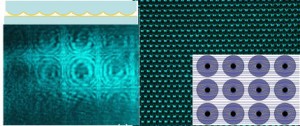Our experiment is based on the recent demonstration of broadband invisibility cloak, which relies on a curved waveguide mimicking the metamaterial properties necessary for cloaking. Since a gap between a gold-coated spherical lens touching a gold-coated planar glass slide provides a good approximation of the required waveguide shape, such geometry can be easily transformed into a large array of broadband invisibility cloaks using commercially available microlens arrays. Very large arrays of roughly 25000 cloaks were used to “hide” approximately 20% of the surface area. This is the first experimental arrangement which lets you study mutual interactions of a very large number of invisibility cloaks.
On the other hand, since light is “stopped” near each cloak, and the cloak radius depends on the light wavelength, the cloak array produced in our study may be used in the “spectroscopy on a chip” applications. The “trapped rainbow” effect observed near each cloak may find applications in such fields as biosensing and testing for genetic decease. Stopping light at the cloak boundary leads to considerable enhancement of fluorescence near each cloak in the array.
This work generated a wide press coverage including BBC News, Physics World, EurekAlert!(AAAS), etc.

![fluoresc[1]](https://wp.towson.edu/vsmolyan/files/2016/05/fluoresc1-15dop1o-300x101.jpg)
Our work Experimental demonstration of a broadband array of invisibility cloaks in the visible frequency range http://iopscience.iop.org/article/10.1088/1367-2630/14/5/053029 has been selected for inclusion in Institute of Physics Select. http://iopscience.iop.org/1367-2630/page/Highlights of 2012 (IoP Select is a special collection of journal articles, chosen by our Editors based on one or more of the following criteria: *Substantial advances or significant breakthroughs *A high degree of novelty *Significant impact on future research, it has also been selected by the editors of New Journal of Physics for inclusion in the exclusive ‘Highlights of 2012’ collection. Papers are chosen on the basis of referee endorsement, novelty, scientific impact and broadness of appeal.)
Trapped rainbow techniques for spectroscopy on a chip and fluorescence enhancement
V. N. Smolyaninova, I. I. Smolyaninov, A. V. Kildishev and V. M. Shalaev, Applied Physics B 106, 577 (2011)
Supported in part by NSF grant DMR-1104676